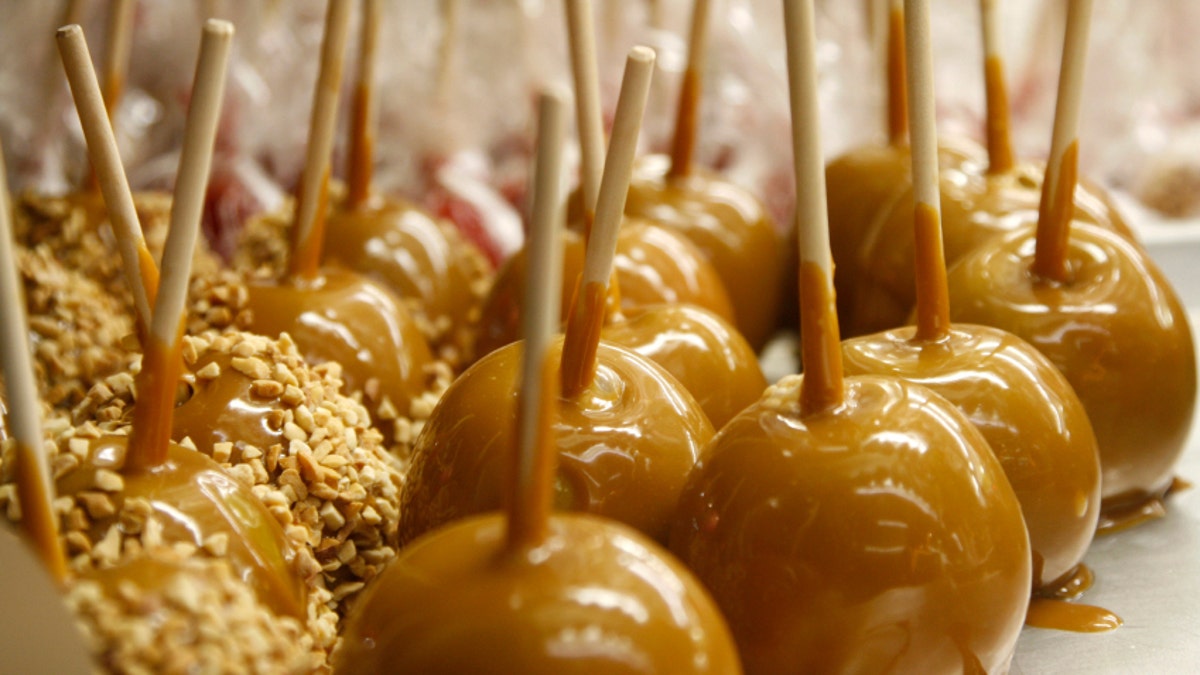
Freshly made caramel apples on a tray.
Researchers may have finally found the source of a 2014 Listeria outbreak that was traced to caramel apples, a new study finds.
It's been a mystery how the bacteria got into the apples and led to the outbreak, which infected 35 people across the U.S., including seven who died, according to the new study.
Caramel apples were not considered to be a hospitable breeding ground for the disease-causing bacteria, Listeria monocytogenes.
The juice from apples is acidic, and that acidity makes it hard for bacteria to grow, said Kathleen Glass, the associate director of the University of Wisconsin-Madison's Food Research Institute and lead author on the study.
That acidity, combined with the low amount of water available in caramel, should have meant that the food was safe, Glass told Live Science. Listeria bacteria need water to grow.
The researchers suspected that the problem "had to be from damaging the apple," she said.
The source of that damage turned out to be none other than the stick inserted into each apple to turn the caramel-dipped fruit into a handheld treat, according to the new finding.
Pushing the stick into the apple changes the environment within it, Glass said. The researchers speculated that when the stick is poked into the apple, juice comes out, and that juice could get trapped between the apple and its caramel coating, she said. The caramel could neutralize the acidity of the apple juice, changing the treat from an inhospitable environment for bacteria to a ripe breeding ground for bacteria, she said. [Top 7 Germs in Food that Make You Sick]
To test this hypothesis, the researchers purchased 12 dozen Granny Smith apples and contaminated them with a mixture of four strains of Listeria (all of which were implicated in the 2014 outbreak). Both Granny Smith apples and Gala apples were implicated in the outbreak, but the researchers used Granny Smiths in the experiments because "their exceptionally [high acidity] represents a steeper hurdle for bacterial growth," the researchers wrote in their study, published today (Oct. 13) in the journal mBio.
"Then, we made caramel apples," Glass said. The researchers put sticks in half of the apples, and left them out of the other half, she said. The researchers dipped the apples without sticks into the caramel using kitchen tongs, according to the study.
Glass noted that the dipping process actually provides protection against bacteria.
"Anything on the surface [of the apples] will die from the hot caramel," she said. The trouble lies in the spots on the apple that aren't submerged in the sauce, such as the stem area and the calyx region (on the opposite end of the apple from the stem, where the flower blossom would be). Those spots in particular can harbor bacteria, she said.
After dipping, the researchers placed the caramel apples in containers and stored half at room temperature (77 degrees Fahrenheit, or 25 degrees Celsius), while the other half were refrigerated, at 45 F (7 C). The researchers checked on the apples every few days to measure Listeria growth, Glass said.
After three days, there was a lot of Listeria growth on the room-temperature apples with sticks in them, Glass said. By contrast, it took about two weeks for Listeria to grow on the refrigerated apples with sticks. As for the apples without sticks, the researchers observed Listeria growth on the unrefrigerated apples after one week. For the refrigerated apples without sticks, the researchers observed no Listeria growth, even after three weeks, they wrote in their study.
Glass said that people don't need to stop eating caramel apples. But retailers should limit the amount of time that the apples are left out without refrigeration, she said. In addition, caramel apple producers are trying new ways to sanitize the whole apple, so the stem and calyx don't harbor bacteria, she said.
But the safest way to enjoy a caramel apple is to eat it immediately (after it has cooled), she said.
Copyright 2015 LiveScience, a Purch company. All rights reserved. This material may not be published, broadcast, rewritten or redistributed.
